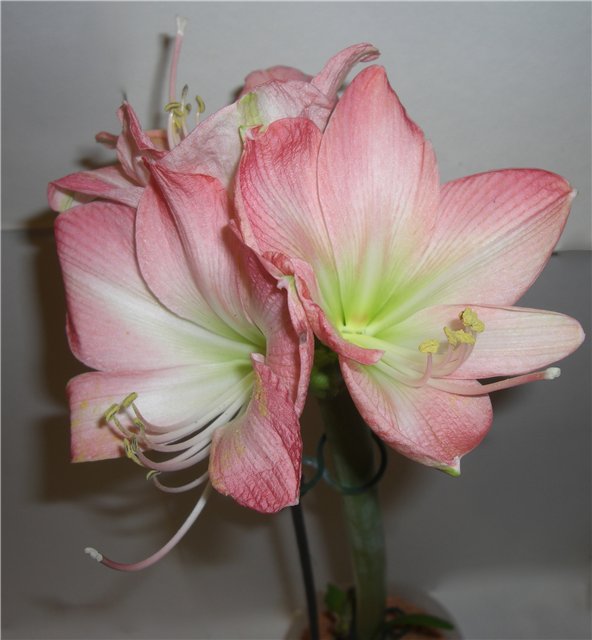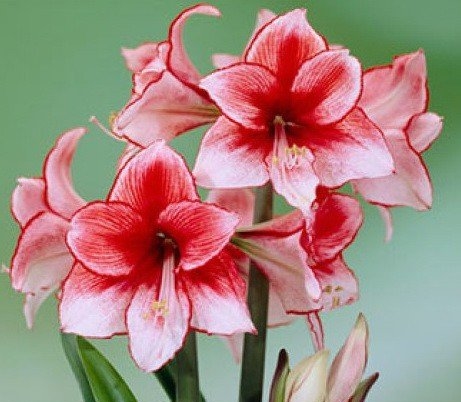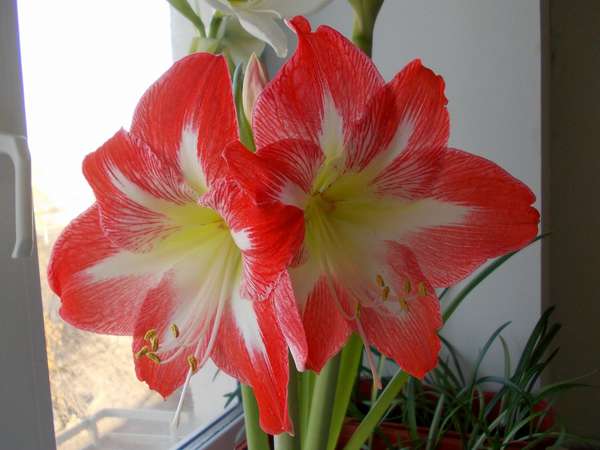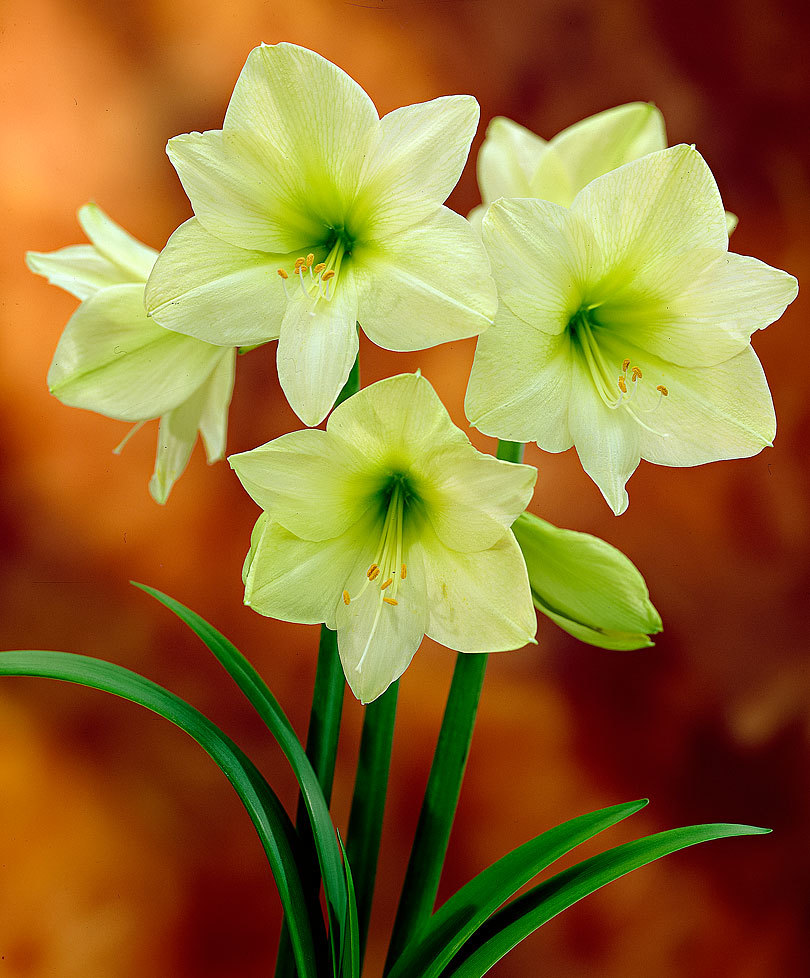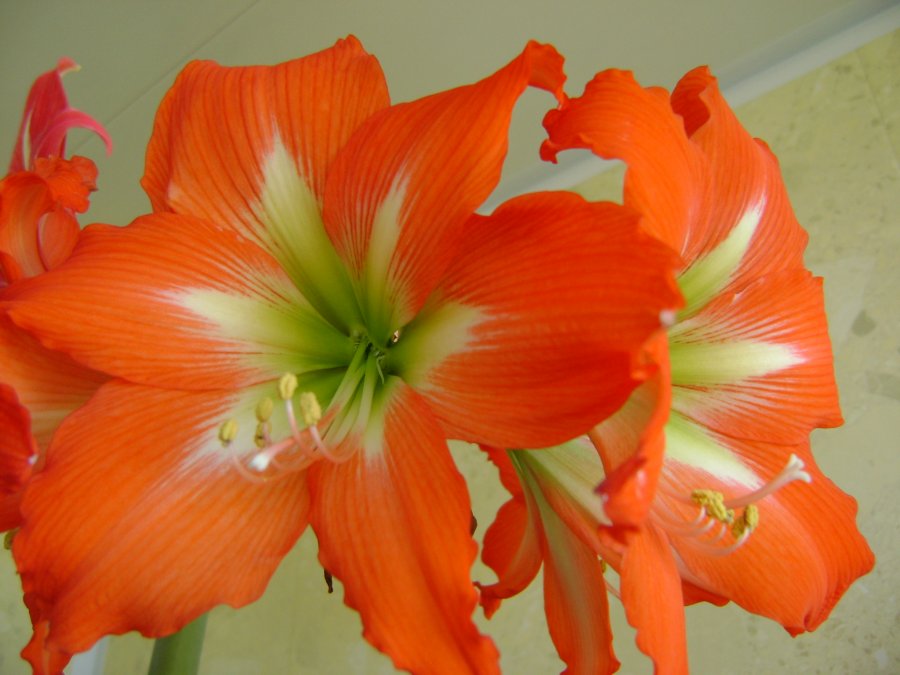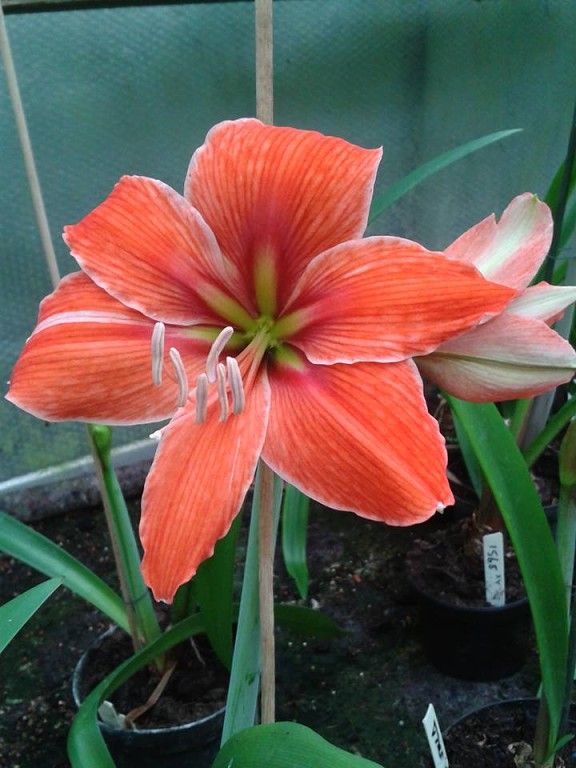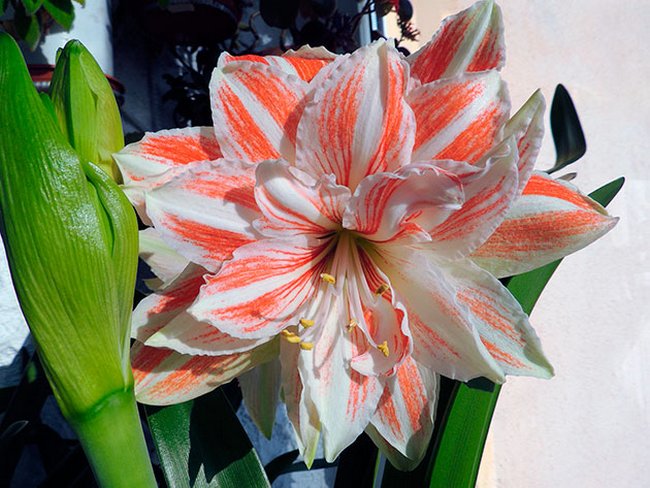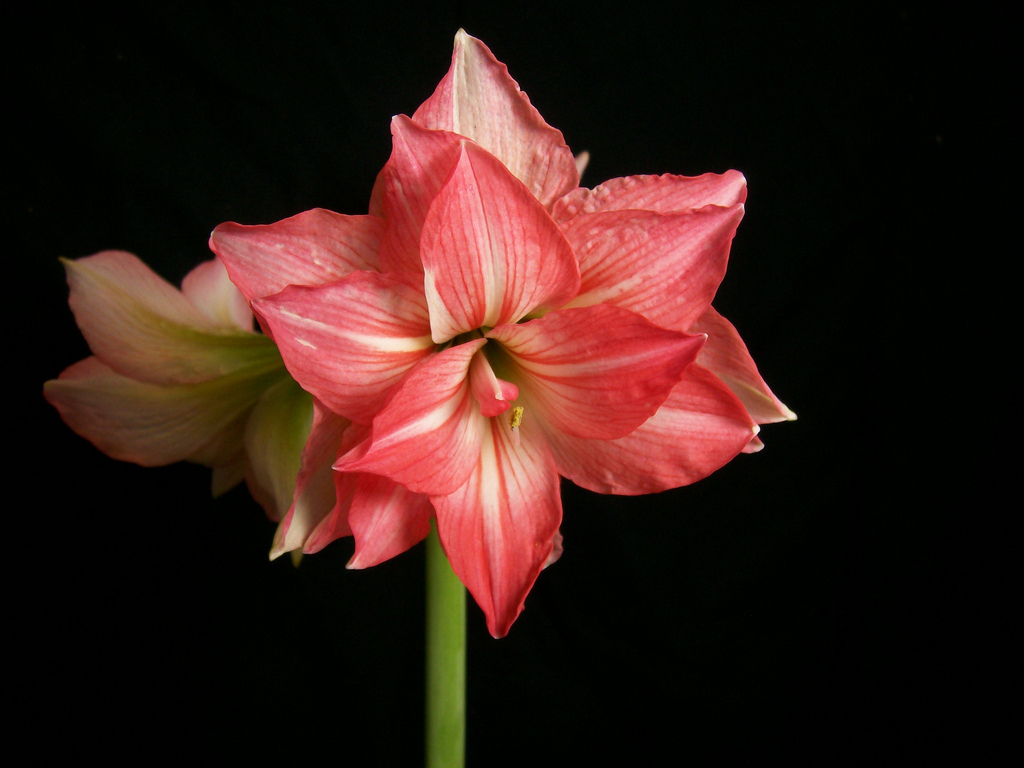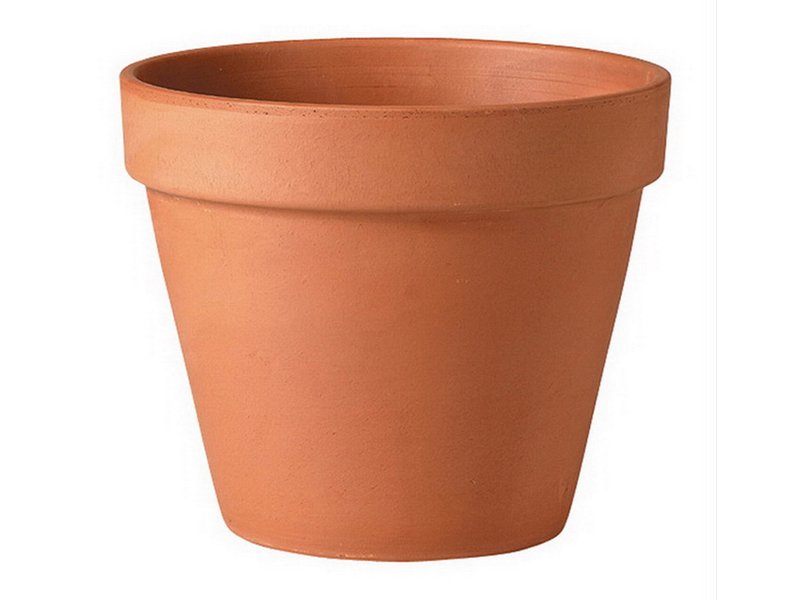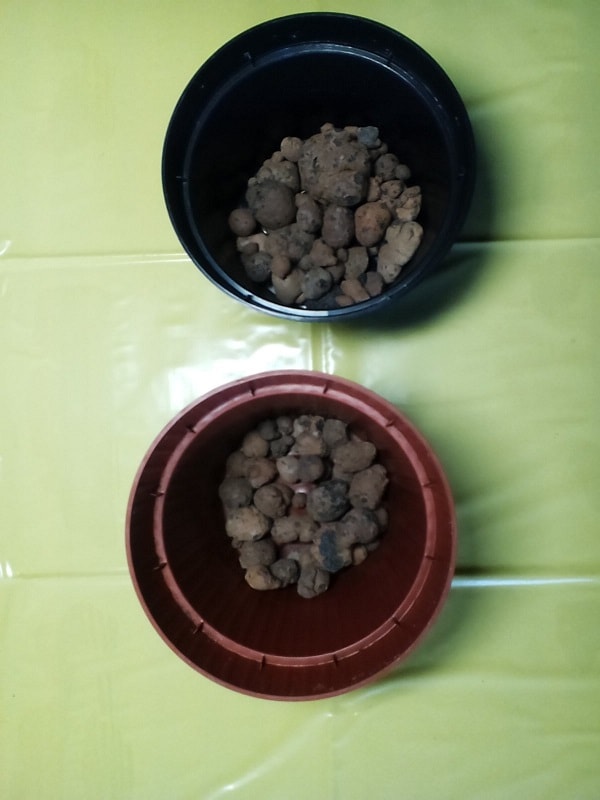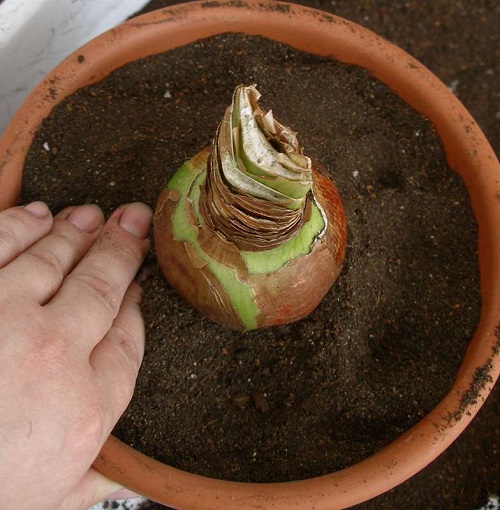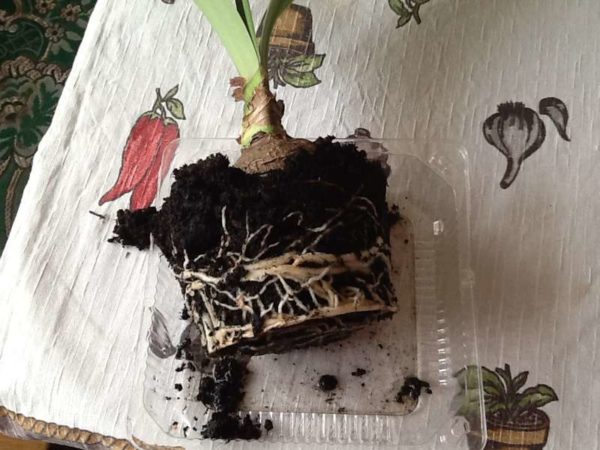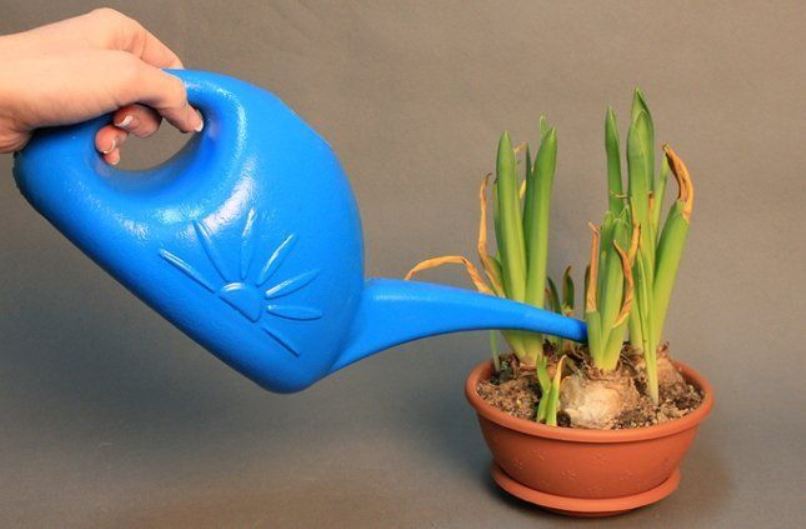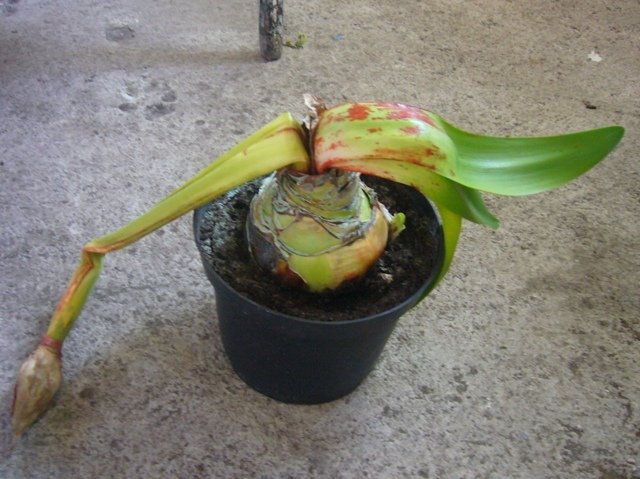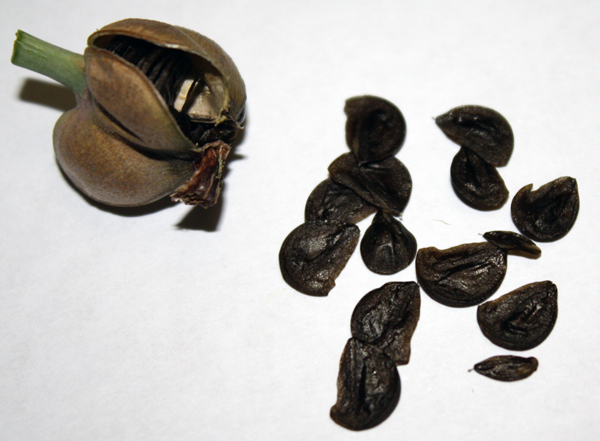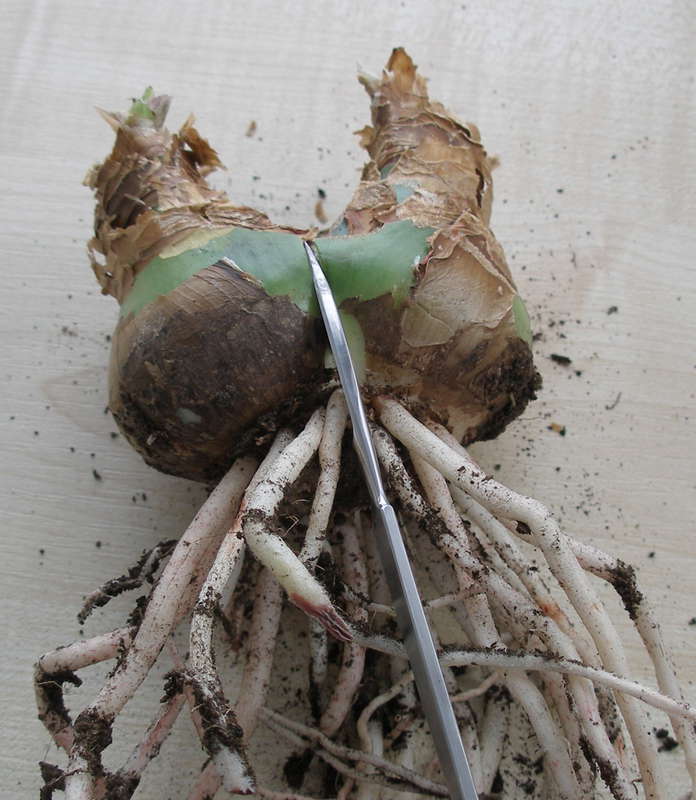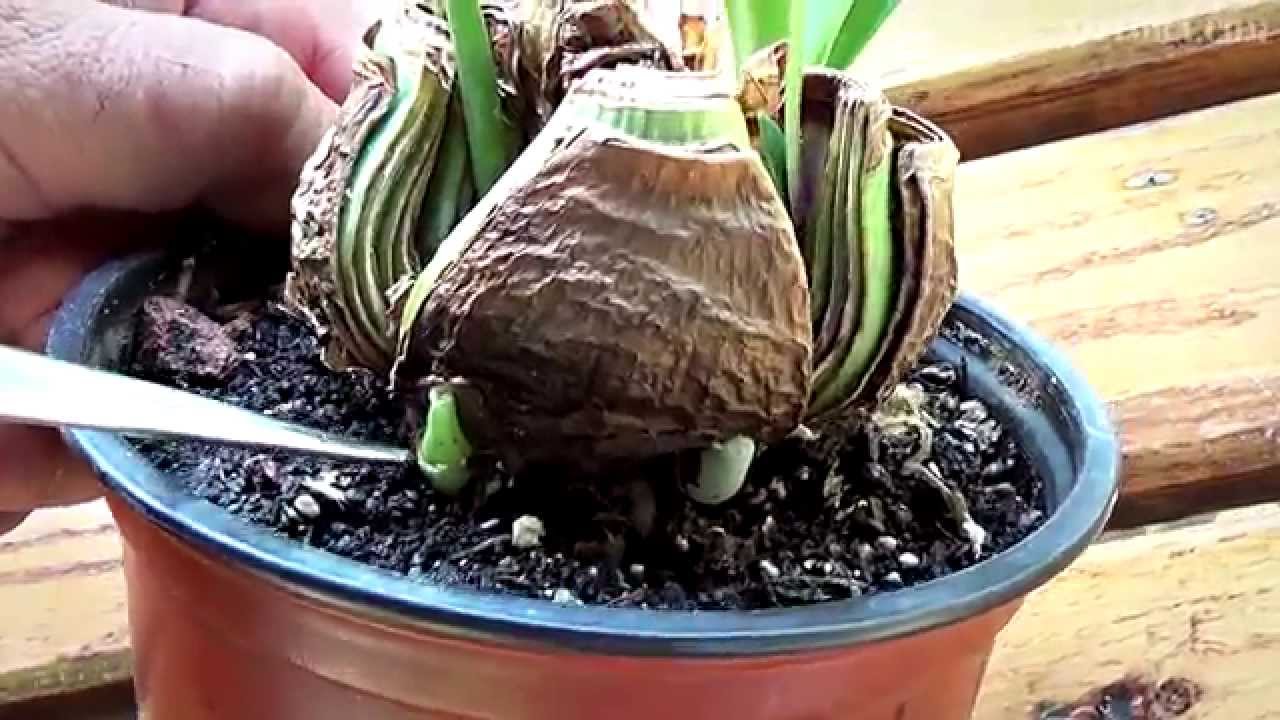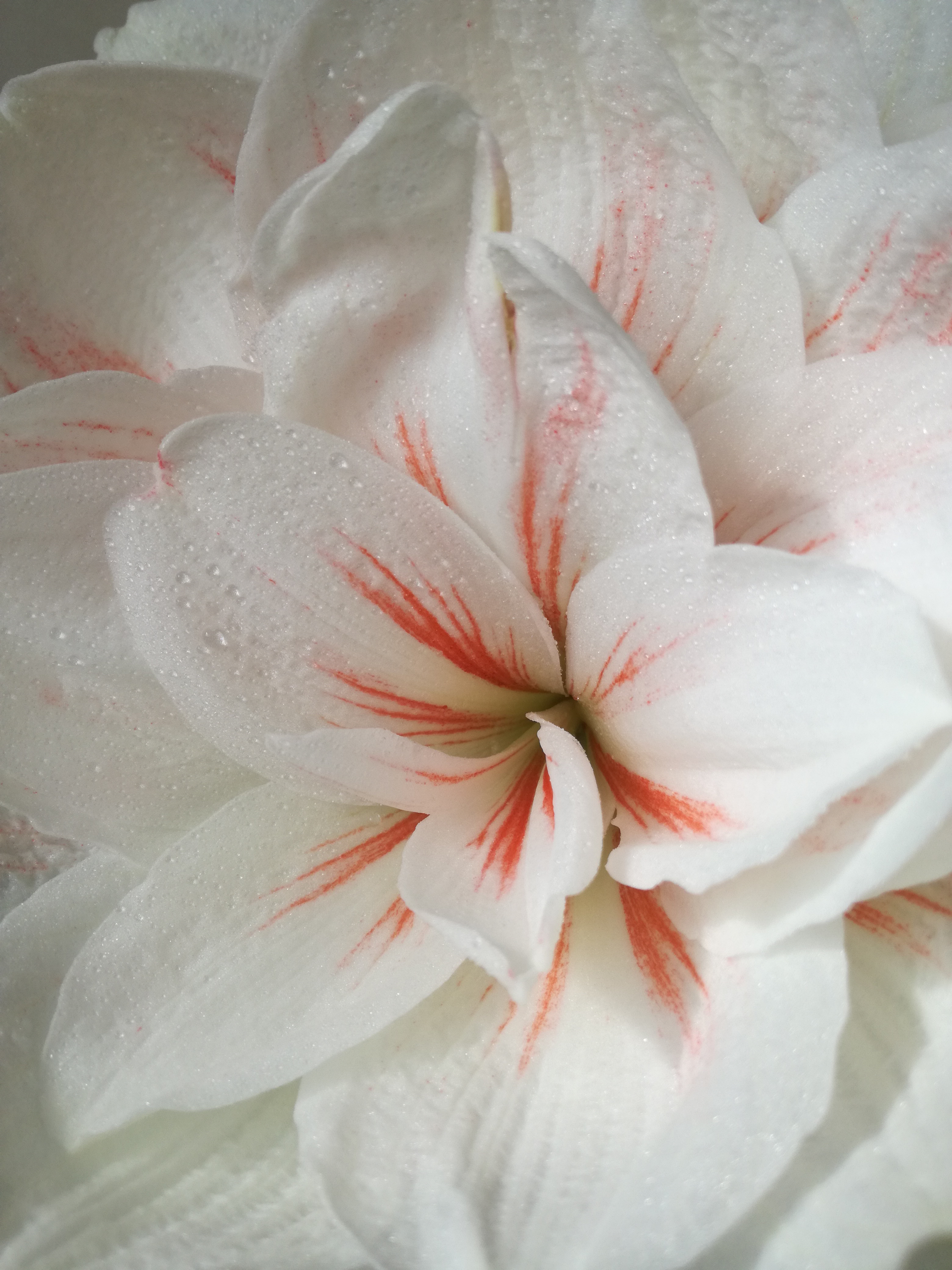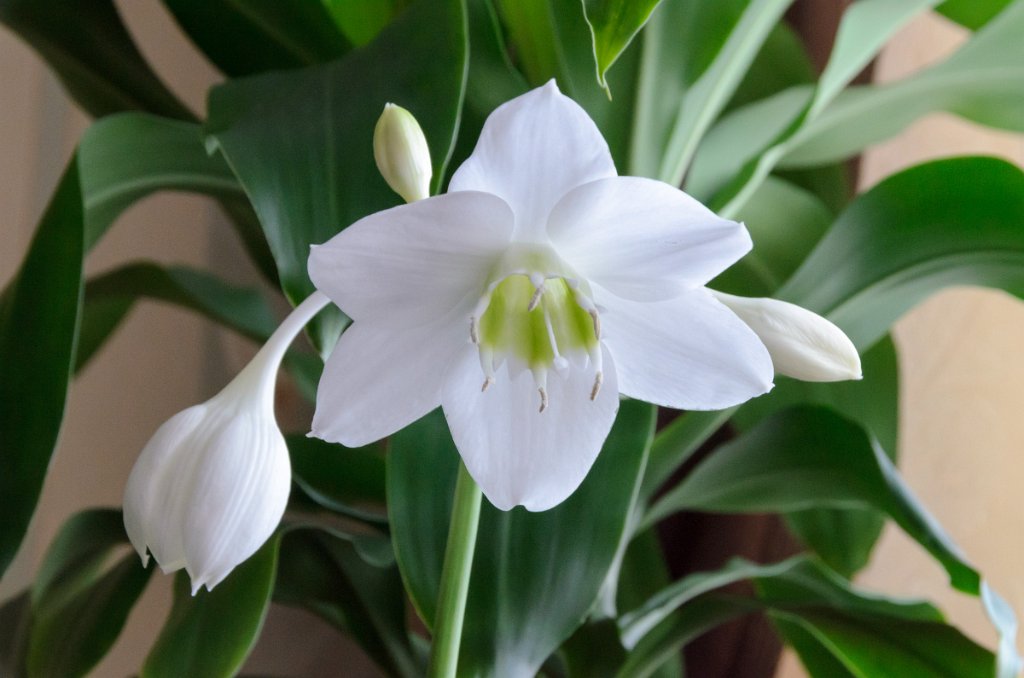Hippeastrum is a houseplant that blooms with beautiful flowers of white, red and pink shades. In nature, it grows in a subtropical climate. At home, you can grow a hybrid that is not so whimsical to environmental conditions. In order for the plant to bloom regularly, you must follow all the rules for caring for it. Some secrets will help you avoid problems and keep the hippeastrum healthy.
Content
What it looks like in nature
Hippeastrum is a perennial plant. It grows up to 50-70 cm tall, has wide green leaves and funnel-shaped flowers. The leaves are arranged in two rows, and during flowering, the plant releases a long arrow.
Types and popular varieties with photos
The color range is varied, most often white, pink and red, but there are varieties with orange, purple and yellow flowers. There are colors with ornaments (strokes or specks). The smell of flowers is almost not caught, and some varieties do not have it at all. Caring for hippeastrum at home is quite difficult for a beginner in floriculture, so people with experience prefer to grow this flower.
Apple Blossom
This species belongs to simple large-flowered plants. The flower is pink with a red bit in a greenish throat. The saturation of pink is directly dependent on lighting.
With insufficient light, the flowers will be pale.
Double Dream
Large-flowered variety with a pink tint. For one flowering, it gives up to 6 flowers up to 20 cm in size.
Charisma
Bright red with white, two-colored flower, grows rather slowly, requires keeping in the cold up to 14 weeks. He usually produces two arrows at once, blooms every 6 weeks.
Minerva
The variety also has flat, wide-open flowers with a feathery pattern. The peduncle usually produces up to 4 red-white flowers.
Lemon Star
The variety belongs to simple medium-flowered. It has white flowers with a yellow-green throat. The flower can have a lemon hue, it looks like a daffodil.
Orange rogue
The great advantage of a flower is that it is completely odorless. It will delight any allergy sufferer.
The variety was first registered in 2008.
Santa cruz
This variety belongs to small-flowered, flowers grow up to 12 cm in diameter. It is suitable for planting and at a summer cottage.
Blossom Peacock
The plant belongs to large-flowered terry species and has an interesting flower color, suitable for mass planting. The first flowering occurs 8 weeks after planting.
Zombie
The main feature of the variety is that it is two-colored. With good care, up to 9 flowers appear on one arrow. The first flowering is observed one month after planting.
La Paz
Outwardly, it is very different from other plant varieties: the flower has smaller, elongated petals. Each flower lasts about 8-10 days from the moment of flowering.
Papilio
The flowers look like an orchid.On one peduncle, 2-4 flowers can form.
Pink floid
The wavy edges of the flower are a feature of this variety. There is a white stripe in the center of the petals, and the throat is bright green. Blooms 7 weeks after planting.
Differences with amaryllis: table of characteristics
Hippeastrum is a relative of the amaryllis, which causes confusion among novice gardeners or hobbyists.
Such differences can only be noticed by a professional, since they lie in the botanical features of plants.
Growing at home
The beauty of a flower directly depends on the conditions in which it grows. After each flowering, the plant definitely needs rest. If you do not provide rest, the flower will cease to bloom and may die.
A high-quality peduncle can only grow if the bulb has been correctly removed from dormancy. With a sharp awakening, the flower will give a lot of greenery, but it will have no strength left for high-quality bloom.
Conditions of detention: table by seasons
Plant conditions must constantly change depending on the season and life cycle. This will help the hippeastrum to grow and develop fully.
| Life cycle | Season | Temperature | Humidity | Shine | A place |
| Rest | Mid September - end of January | 10-12 ° C | Spraying the bulb with water every few days | Complete absence | Cellar, basement |
| The appearance of the first leaves | End of January - beginning of February | 25-30 ° C | Sparse watering in small amounts so that the land is practically dry | Dim | Keep indoors away from the window |
| The appearance of the flower arrow | First half of February | Above 20 ° C - accelerates peduncle development. 16-18 ° C - slows down the growth of the peduncle | Gradually increase watering to moderate soil moisture | Bright, diffused | On the window |
| Bloom | Towards the end of February or beginning of March | Above 20 ° C - reduces flowering time. 16-18 ° C - prolongs flowering | Regular watering | Bright, diffused | On the window, preferably on the south side of the apartment. Requires regular flower rotation for uniform growth |
| Growing leaves | second half of March - mid-September | 18-22 ° C | A gradual decrease in humidity until the complete cessation of watering | Maximum bright | Outdoors without exposure to sunlight and excessive moisture |
Compliance with all conditions will help maintain the health of the plant.
Landing rules: step by step instructions
The time of the procedure is chosen depending on the desired flowering time, on average, this period occurs in 4-8 weeks.
After planting, the plant is placed in a warm place, you can cover it with an empty pot on top to ensure darkness. Watering is prohibited until the peduncle germinates by 10 cm.
Hippeastrum transplant is performed 3-4 times a year. The best time for the procedure is considered to be the rest time or its end. During transplanting, you can use the transfer method, that is, move the plant to another pot along with the earth. This method will help to avoid trauma to the roots.
How to water properly
The intensity of watering depends on the life cycle of the plant (examples were described in the table above). In addition to the correct amount of moisture, proper watering is required to keep the plant roots from rotting.
It is forbidden to pour water on the bulb, as this leads to its death. For hippeastrum, combined watering is better - a plate of water and top watering. The leaves of the plant should be wiped off with a damp cloth.
Top dressing of hippeastrum is carried out regularly, at the beginning of the growing season - once every two weeks with liquid nitrogen-phosphorus-potassium (7: 3: 6) fertilizer (for deciduous plants). After the appearance of leaves, to stimulate the active formation of buds, hippeastrum requires less nitrogen and much more potassium, so the ratio of mineral components changes to proportions of 4: 6: 12 (for flowering plants). The frequency of feeding is maintained.
A month before the onset of the dormant period, the hippeastrum needs fertilizers with an insignificant part of nitrogen and phosphorus and a large amount of potassium (4: 4: 12).
When using ready-made fertilizers, it is important to observe the dosage indicated on the package, since otherwise the root system can be severely damaged, which will lead to the death of the flower.
Bloom
It so happens that the hippeastrum does not want to bloom. The problem might be as follows:
- depletion of the bulb;
- depletion of the soil;
- damage by pests;
- increased soil moisture.
To observe beautiful flowering every year, such situations should not be allowed. The following gardening secrets can guarantee flowering:
- before planting, the bulb is treated with 45 degrees of water;
- stop watering at the end of summer and keep it in the dark until January;
- cut off all the leaves in July and stop watering, then introduce liquid top dressing after 30 days.
After the plant has faded, it must be well fed and prepared for a long rest.
How to provide rest for a flower
Rest plays a huge role in flower health. The natural resting period lasts from September to January. If in the summer the plant was in the fresh air, then in the winter it should be brought indoors and gradually reduce watering until it stops completely.
Leave the bulb in a pot and place it on the floor. Keep the plant at a temperature of 5-16 degrees, periodically spraying the soil with water. The rest period is maintained from 1.5 to 3 months. When the time comes, the bulb will begin to wake up.
If self-awakening did not occur, then most likely the bulb was weakened. If she wakes up on her own, but it's too late — lush flowering can not be expected. To improve the condition, it is required to keep the plant warm, water it regularly and feed it.
The main problems and their solutions
Since it is quite difficult to care for a plant, many novice gardeners make mistakes that affect the condition of the flower.
| Mistake | How does it manifest | Solution methods |
| Lack of rest | Lack of bud formation and flowering period | Adhere to basic watering rules for each life cycle, maintain the correct temperature regime |
| Low temperature | ||
| Bad light | ||
| Improper watering | ||
| Lack of a balanced diet | ||
| Improper watering | Stopping growth and development, decay of the bulb and roots, the development of pests | Dig up and dry the bulb, remove the affected parts of the plant, transplant into a new pot with clean soil |
| Increased dampness and low temperature | Darkening of colors, formation of black spots | Cut off damaged parts of the plant, remove it in a warm place and observe the watering regime |
| Insufficient feeding and increased dryness of the air during the growing season | The formation of brown spots on the tips of the leaves | Conduct fertilizing with mineral fertilizers |
| Increased lighting brightness | Pale flower | Provide diffused light, remove from the sun |
Diseases and pests
The plant is rarely sick, but it is prone to infection with red fungus, rot or powdery mildew. Spider mites, scale insects, aphids, worms harm the flower. It is possible to determine the infection by changing the appearance.
Sick flower
| Problem | Causes | Signs | Effects | Eliminating the problem |
| Red burn mushroom | Fungal spores are carried by the wind and infect healthy plants | Red spots on all parts of the flower | Curvature and wilting of leaves, damage to children, peduncle disease | Spraying the affected parts with a fungicide. Treat the onion with a mixture of chalk with copper sulfate in a ratio of 20: 1 and dry the onion for a week. |
| Powdery mildew | Viral lesion | The appearance of silver on the leaves | The leaves become soft, the peduncle is short or completely absent | Fungicide treatment |
| Red rot | High humidity | The appearance of wilting and leaf rot | Decay of the root system, lack of peduncle, general wilting of the flower | Removal of affected plant parts, drying of the bulb and treatment with foundationol, transplanting into new soil |
| Mealybug | Infection from other plants or the acquisition of a diseased bulb | Cobweb-like white coating | Significant retardation of plant growth and development | Removal of contaminated soil and treatment of the flower with Aktara, Aktellik, Metaphos, Fitoverm, Arriva, Permethrin or Fufanon. Repeat treatment in a week |
| Shield | Release of sticky liquid on plant parts | Stopping growth, shedding leaves | ||
| Aphid | Dense accumulations of inactive insects on young shoots | Loss of color saturation in leaves and flowers | ||
| Spider mite | Spider web on the bottom of the leaves | Yellowing of leaves and peduncles, drying out |
With the right approach, it is possible to cure a flower at home. After recovery, he will again delight with beautiful flowers.
Reproduction
The plant can be propagated in two ways: seed and vegetative.
Growing from seeds
Seed propagation is a rather long process that is not suitable for novice gardeners. Seeds do not appear on their own; artificial pollination is required to breed them. Seeds ripen in special boxes.
Box and seeds
Seeds are planted in the spring in clay soil. Fresh seeds germinate almost 100%, and dried only 30%. The first shoots appear in 2 weeks. Transplanting into a pot is allowed with sprouts at least 6 cm tall. The first flowering with this method of planting appears in 2–5 years.
With bulbs
The most optimal way to grow a plant is with bulbs. At the age of 3 years, the mother flower gives up to 3 children. They are separated with a treated tool and planted in the same way as adult bulbs.
Splitting the onion
For 2 years, new plants do not need foliage cutting and rest. The faster and thicker the leaves grow, the faster the peduncle will appear. With proper care, the first flowering appears in 2-3 years.
Branch
You can divide the onion in November, when the maximum concentration of nutrients is noted in it.
Procedure rules:
- Remove the top layer of the earth.
- Remove top flakes (dry).
- Cut off the top along with the leaves.
- Cut the onion into 4 pieces.
- Place knitting needles in the cuts that will separate the parts from each other.
- Take care of the plant according to all the rules.
- Feed and fertilize when the first leaves appear.
- In the spring, plant in 4 different pots.
When transplanting, it should be borne in mind that the bulbs contain toxic substances that are dangerous to humans. Therefore, the transplant should be done strictly with gloves.
The hippeastrum flower is a beautiful plant that has a variety of varieties that differ in the shape of the flowers and their color. The plant is practically odorless and suitable for home breeding. Looks great for mass planting in the garden. It requires special care, so beginners may have difficulties in growing. With proper care, the plant will live a long time and delight its owner with beautiful flowers.

